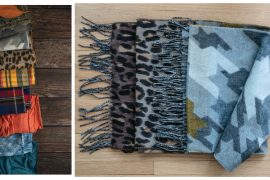Clothing sourced from Stillgood’s Madison and Good Style Shop
For decades, conversations around climate change and sustainability have centered around the cars we drive, the single-use plastics we toss, and the ways in which to conserve water.
But one element has largely stayed out of the spotlight: fashion.
How our clothes are made and how quickly we discard them are one of the leading contributors to climate change.
Manmade fabrics like polyester, acrylic and nylon were engineered to last, well, basically forever. They’re resistant to breaking down in the environment, and when we wash them, these textiles shed 500,000 tons of microplastics into the oceans each year — the equivalent to 50 billion plastic bottles.
Even cotton, a textile that’s generally considered sustainable, is problematic. According to the World Wildlife Foundation, roughly 700 gallons of water are required to make a single T-shirt.
The issue, however, goes beyond the fabric. The industry as a whole is responsible for 10% of carbon emissions — more than international flights and maritime shipping combined, according to Business Insider.
And that’s partially because the majority of our clothing is discarded the same year it is purchased. The EPA announced that there’s currently more than 14 million tons of clothing in landfills.
If that clothing had been recycled, it would be the equivalent of taking 7.3 million cars off the road.
SHOCKING, RIGHT?
This is a lot of doom and gloom, but the good news is that the industry is changing, and resale is booming. A 2019 report from thredUP, an online clothing reseller, noted that the $24 billion resale market was rapidly approaching the $35 billion fast-fashion market. Based on current trends, Statistica predicts that the secondhand apparel market will be worth $64 billion by 2024.
In short, sourcing even a portion of your wardrobe from resale shops can make a big difference.
INSIGHTS FROM THE PROS
PETER BENCK, GOOD STYLE SHOP
Coolest Apparel to Come Through the Shop: Hudson Bay Company blanket coats, Escada silks, Korean War-era Sukajan Jackets, all things Levi’s, Jean Paul Gaultier jackets and separates, Frye Boots, UW throwbacks.
What I Shop For: “Once I have a steady set of things to reliably wear in a season, I just sorta hunt and peck for ornaments to go on top. Now, I’m usually on the hunt for early to mid-century blanket coats, gabardine menswear, Nordic wool fair isle sweaters and Mosquitohead idol worship graphic tees.
GWYNNE TYKSINSKI, STILLGOOD’S MADISON
Coolest Apparel to Come Through the Shop: Hand-knit sweaters, rhinestone jackets, a stunning vintage Gunne Sax dress, Pendleton shirts and jackets, a Universal Standard puffer jacket, fun ’80s jeans.
A Passion for Earth-Friendly Fashion: The fashion industry is one of the largest industries in the world, so you can only imagine what it is doing to our planet. There are so many reasons to buy resale. Most importantly, it’s good for the environment. It also helps save you money, and it’s fun to discover new styles and create unique ways to express your personality.
HOW “DIRTY” IS YOUR CLOSET?
Take this quiz from thredUP to measure your own fashion-related carbon footprint. It takes you through a series of questions and then the algorithm calculates how many pounds of carbon your fashion choices emit annually. thredup.com/fashionfootprint




